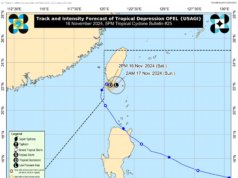Darkness, 500-plus miles above Earth.
When Hurricane Irma roared into Florida on Sunday and Monday, its winds and rains knocked out power for 6.5 million people in the state. That’s more than a quarter of the state’s population without electricity.
“We’ ve never had that many outages, and I don’ t think any utility in the country ever has, ” Eric Silagy, the chief executive of Florida Power & Light, told reporters Monday. His company alone had 4.5 million customers without power. In some areas, restoration of power is expected to take weeks.
So much power was knocked out, you can clearly see it from space.
Here’s an image of Florida from May 11,2017, courtesy of NOAA and NASA’s Suomi satellite, which can spot nighttime city lights from 512 miles above Earth. This is what South Florida normally looks like after dark. At night, Miami, West Palm Beach, Naples, and Key West are aglow with people having a good time. (May 11 was chosen as a reference because there was a similar amount of moonlight that evening.)
And here’s a similar image captures at 3: 21 am September 11, right after Hurricane Irma passed through much of the region. It’s as if someone turned down a dimmer switch on the whole state.
Some of the darkness is due to cloud cover, according to William Straka, a weather researcher at the University of Wisconsin who works on Suomi data and helped create these images.
But not all of it.
“Monroe County, despite being basically cloud free … was dark, as was Marco Island (site of second US landfall) , ” he writes in an email.
Fort Myers, on the west coast of Florida, was under thin clouds. So was Naples. But even so, “you should be seeing some light scattered [in these areas] if the power was on, ” Straka says. Key West was basically cloud-free, and no discernible lights are on in the image.
For perspective, here’s the cloud cover from the evening. Overall: Given the radar, you’ d expect more city lights to shine through.
And here’s the fully zoomed-out image of Florida from last night. The state was made doubly dark from the remnants of the hurricane and the downed power lines it left behind.
When a natural disaster is so widespread — reaching all the way from the Leeward Islands in the Caribbean to now the Southeast of the United States — it can take a space-based view to put it all in perspective.
Here, you can see all the sediment churned up in the Gulf waters by the storm.
Or the scale of the destruction wrought on the Virgin Islands. Verdant green islands are now a muddy brown.
“The most obvious change is the widespread browning of the landscape, ” NASA’s Earth Observatory explains. “Lush green tropical vegetation can be ripped away by a storm’s strong winds, leaving the satellite with a view of more bare ground. Also, salt spray whipped up by the hurricane can damage and desiccate leaves while they are still on the trees.”
What this image can’ t show: whole island communities in St. Martin and elsewhere basically wiped out, with reports of looting, dwindling supplies, and on-the-ground frustration about slow recovery efforts. Irma is expected to cost Caribbean islands at least $10 billion, and the numbers could rise much higher.






